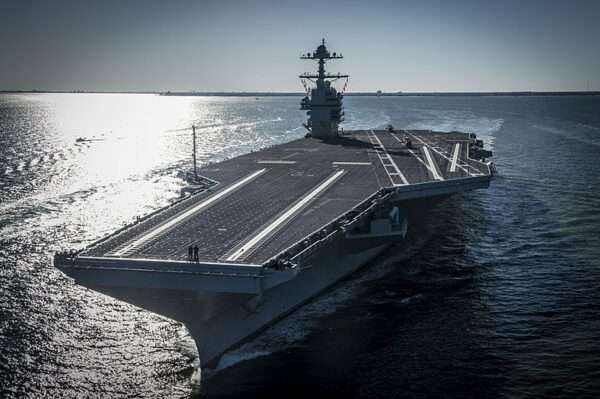The USS Gerald R. Ford (CVN-78) is a leading United States Navy supercarrier. It’s the first of a new class of aircraft carriers named for the 38th United States President, Gerald Ford, who served in the Navy during World War II.
The new class of carrier is the first since USS Nimitz (CVN-68) in 1975, and the first new aircraft carrier introduced to the Navy since the USS George H.W. Bush (CVN-77) in 2009, according to the Navy.

The U.S. Navy aircraft carrier USS Gerald R. Ford (CVN-78) underway on its own power for the first time while leaving Newport News Shipbuilding, Newport News, Virginia (USA), on 8 April 2017. The first-of-class ship — the first new U.S. aircraft carrier design in 40 years — spent several days conducting builder’s sea trials, a comprehensive test of many of the ship’s key systems and technologies. (Mass Communication Specialist 2nd Class Ridge Leoni/U.S. Navy)
USS Gerald R. Ford is the first of 10 planned Gerald R. Ford-class aircraft carriers intended to replace the Nimitz-class carrier, offering significant performance upgrades as compared to the Nimitz class carrier.
“Ford-class ships will deliver greater lethality, survivability, and joint interoperability, along with unmatched versatility and compatibility with continuing joint-force transformation – all at a reduced operating and maintenance cost to taxpayers,” according to the Navy’s All Hands magazine.
Watch the video below to see the USS Gerald R. Ford in action:
It’s the largest aircraft carrier in the world, the largest warship ever in regard to displacement, which is 100,000 tons.
At a cost of $12.9 billion each, it’s also the most expensive warship in U.S. history.
“The next generation of aircraft carrier, the Gerald R. Ford class delivers unprecedented flexibility to the fleet. Due to a larger flight deck, the ability to host more aircraft, additional weapons and aviation fuel storage, and the Electromagnetic Aircraft Launch System and Advanced Arresting Gear, Ford will be able to increase sortie rates by one-third when compared to the Nimitz class,” the Navy statement said.

The church pennant and national ensign are flown above the aircraft carrier USS Gerald R. Ford (CVN 78) while religious services are conducted aboard the ship. Gerald R. Ford is currently underway conducting test and evaluation operations. (U.S. Navy photo by Mass Communication Specialist 3rd Class Joshua Murray/Released)
Shifting away from the traditional steam catapult system, the USS Gerald R. Ford introduces the Electromagnetic Aircraft Launch System (EMALS) to facilitate the launch of all carrier aircraft.
This technology removes below-deck steam generation and storage systems, freeing up critical space, while offering improved acceleration, more accurate speed controls, and improved energy capacity to support a wider array of aerial vehicles.

Sailors prepare to launch a “dead-load” from the ship’s Electromagnetic Aircraft Launch System (EMALS). (U.S. Navy/Released)
The carrier’s Advanced Arresting Gear (AAG) system enables the recovery of current and future tail-hook equipped carrier aircraft, and includes integrated test and diagnostic technologies.
“The Navy’s newest aircraft carrier generates three times the amount of electricity as previous classes and is designed to rapidly add capabilities as new systems become available over the course of its projected 50-year service life,” the Navy statement said.

Sailors assigned to the aircraft carrier USS Gerald R. Ford (CVN 78) load an F/A-18F Super Hornet assigned to Air Test and Evaluation Squadron (VX) 23 onto the electromagnetic aircraft launching system. Gerald R. Ford is underway conducting test and evaluation operations. (U.S. Navy photo by Mass Communication Specialist 3rd Class Cathrine Mae O. Campbell/Released)
USS Gerald R. Ford completed its sea trials on May 26, 2017, and was delivered to the Navy on May 31, 2017. It was commissioned July 22, 2017 in a ceremony with President Donald Trump.
The carrier’s first deployment is expected to take place in 2022.



